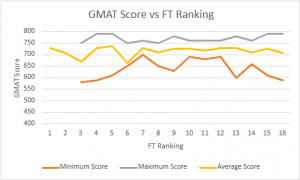The first thing a student looks at while applying to their target B-schools is the average GMAT score of those studying in that school. Most leading business schools provide a range of the GMAT scores of their students as well. If you already have a good GMAT score, you would be looking for universities that accept applications with similar GMAT scores, or if you are starting to plan for an MBA, you might be looking for a target GMAT score to get into your dream B-School.
Take Free GMAT 2023 Daily Targets
Subscribe To GMAT Preparation Channel
GMAT Score Range
The GMAT ranges from 200 to 800. Many b-schools don’t generally set a minimum GMAT score requirement. In reality, admission decisions are made holistically, and scores above 700 are usually highly valued among most schools worldwide. A score above 600 can still be advantageous as it is considered a good score by many MBA and business master’s programs. However, even the most competitive schools still accept applicants with scores in the 500s every year.
Admissions teams evaluate applicants based on their overall application strength, considering their work experience, educational background, and GPAs. As a result, top business schools worldwide receive numerous applications with diverse GMAT scores each year.
What Determines Application Strength
The MBA admissions is a holistic process. The admissions committees of all the top universities consider multiple factors, one of which is a good GMAT score. However, there are always students with a much stronger profile but average GMAT scores who get into top MBA programs yearly. These candidates usually have the following:
- Expertise in a topic that could be exciting to their peers.
- Previous career success that suggests the potential for further success later on.
- A personal story that shows they’ve overcome challenges.
If your application lacks either of these, you should focus on maximizing your GMAT score to stand out in your application process.
Target GMAT Score for top b-schools
| FT Ranking | B-School | Range of Scores | Average GMAT Score |
| 1 | Columbia Business School | 540-780 | 729 |
| 2 | INSEAD | – | 708 |
| 3 | Iese Business School | 580-750 | 670 |
| 4 | Harvard Business School | 590-790 | 730 |
| 4 | Stanford Business School | 610-790 | 738 |
| 6 | SDA Bocconi School of Management | 650-750 | 665 |
| 7 | University of California at Berkeley: Haas | 700 – 760 | 729 |
| 8 | Cornell University: Johnson | 650 – 750 | 710 |
| 9 | Northwestern University, Kellogg School of Management | 630 – 780 | 727 |
| 10 | Yale School of Management | 690-760 | 725 |
| 11 | Duke University’s Fuqua School of Business | 680 – 760 | 718 |
| 11 | MIT: Sloan
|
690-760 | 730 |
| 11 | University of Chicago: Booth | 600-780 | 729 |
| 14 | UCLA Anderson School of Management
|
660 – 760 | 711 |
| 15 | Dartmouth College: Tuck
|
610-790 | 726 |
| 16 | London Business School
|
590-790 | 708 |
Correlation Between Score and FT Ranking of Institute
From the table below, it is evident that top B-schools consider a lot more than a good GMAT score to admit students to their MBA programs, as there is no clear correlation between the GMAT score and the institute ranking. However, it is also seen that most good B-schools have
an average GMAT score of more than 700. Hence, even if you don’t have an exceptional profile, a 720+ score can help your application stand out considerably.

It is possible that candidates who have GMAT scores significantly lower than the average class score may excel in other aspects of their application. However, as an applicant to a business school, achieving a high GMAT score is always favourable because it will add strength to your application.
How to Achieve a High Score in GMAT?
The only way to achieve a high score on GMAT is through regular practice. GMATPoint Free Daily Targets is the ideal tool for you to prepare for GMAT and achieve consistency. In Daily Targets, you will get five questions of Quantitative Reasoning and five questions of Verbal Reasoning every day from varied topics, along with detailed Video Solutions. This tool not only ensures that you cover all the topics of the GMAT regularly but also requires only half an hour every day and is entirely free.
You can find plenty of resources and articles in our GMATPoint Blog, from creating a routine for your preparation and tips on approaching QA and VR topics to what you should be doing right before your exam day.
You can also watch our free classes to learn how to solve difficult GMAT-level questions and understand complex concepts clearly.
Do reach out to us at support@gmatpoint.com for further assistance.
All the best.
Also Read:
- What Is GMAT? – Everything to know about the test
- How To Prepare For GMAT In 1 Month?
- What Is Tested In GMAT Verbal? How To Improve Verbal In GMAT?
- Introduction To GMAT Verbal Reasoning (With Solved Examples)
- How To Improve In GMAT Sentence Correction: Tips, Tricks, and Strategies
- 6 Interesting Facts About The GMAT Exam You Should Know
- GMAT preparation for beginners: What to Study and How
- 6 Best Practices for GMAT Preparation: The Ultimate Study Guide
- How To Study For GMAT With Full-time Job?
- Can You Study for GMAT On Your Own? A Step-by-step Approach
- Is GMAT Easy To Crack? What Makes GMAT Challenging
- How to start your GMAT preparation | 5 Tips To Crack GMAT
- Top colleges accepting GMAT scores in India
If you are starting your GMAT preparation from scratch, you should definitely check out the GMATPOINT
